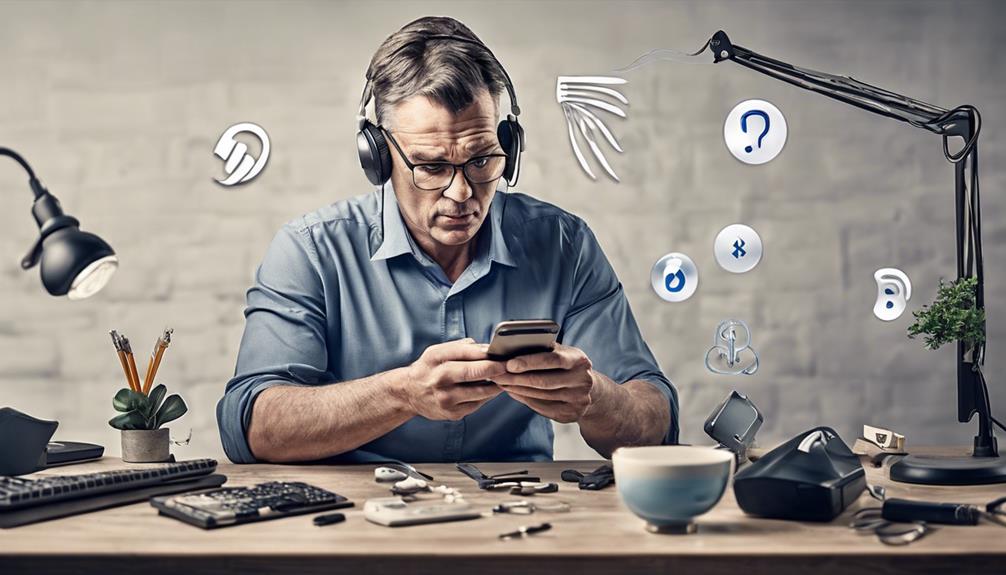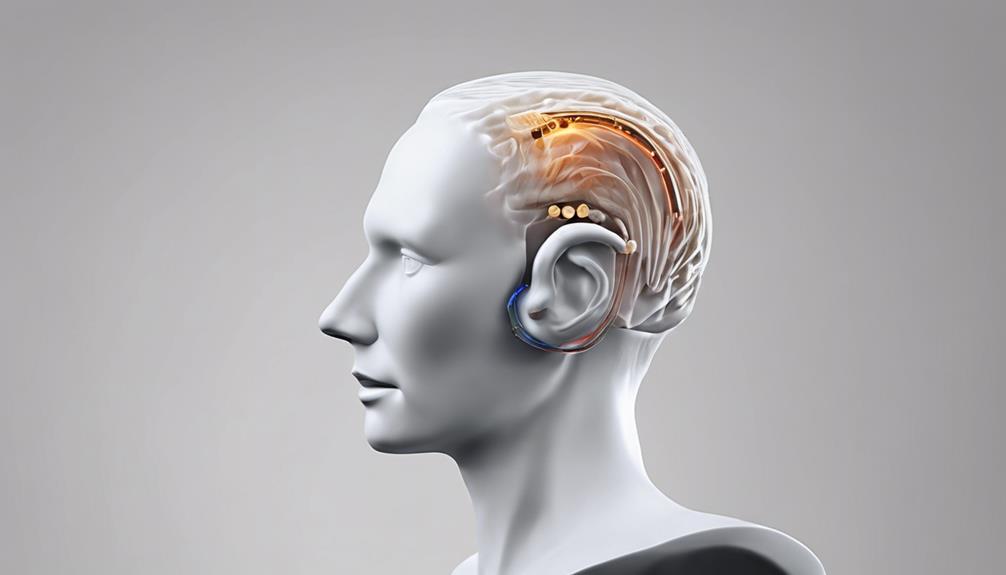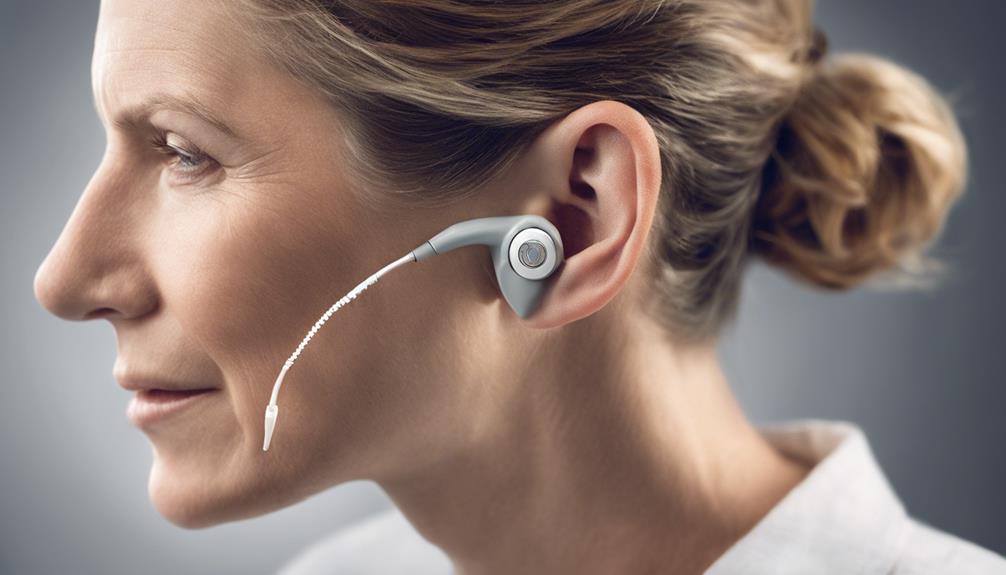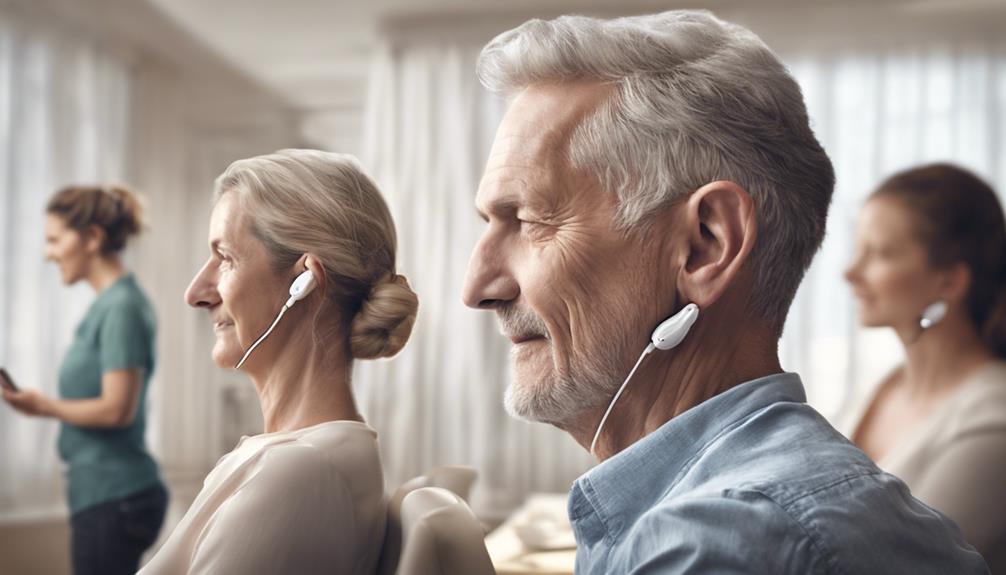Hearing Aids
Budget-Friendly CROS Hearing Aids: Cost-Effective Solutions for Better Hearing
Tune in to explore how Budget-Friendly CROS Hearing Aids offer affordable solutions for improved hearing without compromising on quality.

For those concerned about the expense of hearing devices, Affordable CROS Hearing Aids present a feasible option for enhancing hearing without straining your finances. Employing advanced technology, these hearing aids are designed specifically for people experiencing hearing loss in one ear, delivering a focused and effective method for overcoming hearing difficulties.
Curious about how these cost-effective aids can enhance your hearing experience and fit seamlessly into your lifestyle? Stay tuned to discover more about the benefits and affordability of Budget-Friendly CROS Hearing Aids.
Key Takeaways
- Affordable CROS aids offer quality sound transmission for improved hearing.
- Enhance communication and social interactions effectively with budget-friendly options.
- Ideal for unilateral hearing loss, providing immersive 360° auditory experiences.
- Cost-effective solution to reduce social isolation and improve overall quality of life.
Understanding CROS Hearing Aid Technology
CROS hearing aid technology revolutionizes sound processing for individuals with severe to profound hearing loss in one ear by capturing and wirelessly transmitting sound from the non-hearing ear to the better ear. This innovative approach helps overcome the head shadow effect, where sounds are blocked by the head, improving localization and enhancing communication.
In noisy environments, CROS aids play a crucial role in boosting awareness of surroundings and facilitating clear communication. These aids not only aid in sound processing but also contribute significantly to reducing social isolation that can result from hearing impairment.
Benefits of Budget-Friendly CROS Aids

As we explore the benefits of budget-friendly CROS aids, it becomes evident that these affordable solutions offer a pathway to improved hearing and communication for individuals with unilateral hearing loss.
Here are three key advantages of opting for budget-friendly CROS aids:
- Cost-Effective: Budget-friendly CROS aids provide a cost-effective option for individuals seeking quality hearing assistance without a substantial financial burden.
- Improved Sound Transmission: These aids offer improved sound transmission capabilities, ensuring that individuals with unilateral hearing loss can experience clearer and more defined sound quality.
- Enhanced Communication: By investing in budget-friendly CROS aids, users can enhance their communication abilities, making it easier to engage in conversations and interact with others effectively.
Choosing a budget-friendly CROS aid not only helps in managing unilateral hearing loss economically but also ensures that individuals receive the necessary support to improve their overall hearing experience and quality of life.
Cost Comparison of CROS Devices
When exploring the cost comparison of CROS devices, individuals seeking hearing solutions for unilateral or asymmetrical hearing loss often encounter a range of pricing factors to consider. CROS devices can range in cost from $3,000 to $5,000 per pair, depending on the brand, features, and provider.
Similarly, BiCROS aids, which amplify sound to the better ear, fall within a comparable price range. This investment can be significant for those with unilateral or asymmetrical hearing loss, with some models costing several thousand dollars.
While insurance coverage for CROS or BiCROS aids isn't widespread, certain plans may cover expenses like hearing tests or fittings. Therefore, when evaluating CROS devices, it's essential to weigh the costs against the features and benefits they offer to identify a budget-friendly option that aligns with your unique hearing requirements.
Who Can Benefit From CROS Aids

Individuals experiencing hearing difficulties in one ear while maintaining good hearing in the other can benefit significantly from CROS aids. These innovative devices cater to those with unilateral or one-sided hearing loss, offering practical solutions to enhance auditory experiences.
Here are three key points highlighting who can benefit from CROS aids:
- Partial to Total Hearing Loss: CROS aids are specifically designed for individuals with varying degrees of hearing loss in one ear, whether it be partial or total, providing tailored support for their unique needs.
- Addressing Conversation Challenges: CROS aids excel in improving communication by enabling individuals to hear sounds from all directions, overcoming the challenges faced in conversations and social interactions.
- 360° Hearing Enhancement: By offering 360° hearing capabilities, CROS aids ensure that individuals with one-sided hearing loss can perceive sounds from all around them, contributing to a more immersive auditory experience. These benefits make CROS aids a cost-effective and valuable solution for those seeking to improve their quality of life through enhanced hearing.
Enhancing Quality of Life With CROS
Enhancing one's quality of life with CROS Hearing Aids involves fostering a deeper connection to the sounds and conversations that shape our daily experiences. For individuals with unilateral hearing loss, CROS aids play a crucial role in improving their overall quality of life.
By enhancing awareness of surroundings and facilitating better communication, these devices help users navigate noisy environments with ease. The elimination of the constant need to turn one's head to hear sounds not only improves convenience but also reduces social isolation often associated with hearing difficulties.
Moreover, CROS aids contribute to enhanced safety by assisting in the identification of important sounds, enhancing the overall well-being of the individual. Embracing the benefits of CROS Hearing Aids can lead to a more fulfilling and enriched auditory experience, allowing individuals to actively participate in conversations and engage more fully in their surroundings.
Frequently Asked Questions
What Is the Alternative to a Cros Hearing Aid?
When looking for an alternative to a CROS hearing aid, bone conduction hearing aids can be a great option.
These aids work by bypassing the ear canal and inner ear, transmitting sound directly to the cochlea through bone vibrations.
They're particularly beneficial for individuals with conductive hearing loss or single-sided deafness.
Additionally, they can be a cost-effective solution compared to traditional hearing aids for certain types of hearing loss.
Are Inexpensive Hearing Aids Effective?
Yes, inexpensive hearing aids can be effective, especially for mild to moderate hearing loss. While lacking advanced features, basic models can still improve hearing. They're suitable for many individuals and offer a cost-effective solution for better hearing.
Keep in mind that budget-friendly options may not provide as much customization for specific environments, but they can still enhance overall hearing quality.
What Is the Disadvantage of Cros Hearing Aid?
When we talk about the disadvantages of CROS hearing aids, one significant challenge is the potential for sound overload in one ear. This can sometimes lead to difficulties in accurately localizing sounds, which may require an adjustment period.
Not everyone with hearing loss may find CROS aids suitable due to these limitations. It's essential to consult with a Hearing Care Professional to address any potential challenges and ensure the best hearing solution for each individual.
What Is the Success Rate of Cros Hearing Aid?
The success rate of CROS hearing aids is high, benefiting individuals with unilateral hearing loss by significantly improving speech understanding and sound localization. Users report increased awareness of sound sources and better communication in challenging environments.
Success depends on proper fitting and adjustment by a qualified audiologist. Overall, CROS aids have proven effective in addressing the challenges of single-sided hearing loss.
Conclusion
As we journey through life, let Budget-Friendly CROS Hearing Aids be the guiding light in our path to better hearing.
Like a gentle breeze on a warm summer day, these cost-effective solutions whisper hope and clarity into our world of sound.
With each step we take, let the symphony of life's melodies be heard with renewed vibrancy and joy.
Embrace the gift of improved audibility and cherish the moments of connection and communication that lie ahead.
Hearing Aids
Troubleshooting: Why Do My Hearing Aids Keep Disconnecting From Bluetooth
Wondering why your hearing aids keep disconnecting from Bluetooth?

It has been observed that 45% of users with Bluetooth-enabled hearing aids often experience problems with frequent disconnections.
It can be frustrating when your hearing aids keep disconnecting from Bluetooth at crucial moments.
Let's uncover the common culprits behind this problem and explore effective troubleshooting strategies to ensure a seamless connection experience that enhances your hearing aid benefits.
Key Takeaways
- Check battery levels and interference sources to prevent disconnections.
- Ensure proper pairing and update software for stable Bluetooth connections.
- Troubleshoot one-sided audio or feedback issues promptly.
- Maintain device proximity, update software, and minimize interference for consistent connectivity.
Common Reasons for Disconnection
Bluetooth disconnections from hearing aids can be frustrating, often stemming from various common reasons that users encounter. Low battery levels in hearing aids are a frequent culprit for these disconnections. When the battery is low, the Bluetooth connection may become unstable and lead to intermittent disconnectivity.
Additionally, interference from other electronic devices can disrupt the Bluetooth signal, causing disruptions in the connection. Software updates on smartphones or hearing aids can also play a role in Bluetooth disconnections. Sometimes, after an update, the devices may have difficulty communicating effectively via Bluetooth, resulting in connection issues.
Furthermore, body movements and proximity to the Bluetooth source can impact signal stability. Moving too far away from the source or engaging in vigorous movements may cause disruptions in the connection. When facing Bluetooth disconnection problems, troubleshooting steps such as restarting devices and re-pairing them can often resolve the issues. These simple actions can help re-establish a stable Bluetooth connection between the hearing aids and the source device.
Bluetooth Pairing Issues

When troubleshooting hearing aids disconnecting from Bluetooth due to common reasons like low battery levels and interference, addressing Bluetooth pairing issues becomes crucial for ensuring seamless connectivity.
To resolve Bluetooth pairing problems, start by ensuring that the hearing aids are in pairing mode and correctly connected to Bluetooth. Check for software updates on both the hearing aids and the connected device, such as MFi Hearing Devices, to enhance compatibility.
Properly pair Bluetooth Hearing Aids by following the manufacturer's instructions and adjusting Bluetooth settings as needed. Verify the proximity and positioning of the devices to minimize signal interference that may cause disconnections.
If issues persist, consider performing a firmware update on the hearing aids. Restart both the hearing aids and the connected device to reset the Bluetooth connection. For more advanced troubleshooting, seek assistance from the hearing aid manufacturer's technical support team, who can provide tailored solutions and guidance.
Interference and Feedback Problems
To address interference and feedback problems with hearing aids, minimizing proximity to Wi-Fi routers and electronic devices is essential for optimizing Bluetooth connectivity. When facing issues with disconnections and feedback, consider the following:
- Check the battery levels in your hearing aids as low power can lead to connectivity problems.
- Move away from sources of interference such as crowded Wi-Fi channels or other electronic devices.
- Ensure your hearing aids have a full charge or fresh batteries before attempting to re-pair them with your devices.
- If experiencing one-sided audio streaming, try restarting the affected hearing aid and device, and then re-pair them to resolve the issue.
Troubleshooting Tips and Solutions

When troubleshooting issues with hearing aids disconnecting from Bluetooth, it's crucial to follow specific steps to ensure optimal connectivity and performance.
Firstly, make sure your hearing aids are in pairing mode and that Bluetooth is turned on. Check for potential sources of interference, such as Wi-Fi routers, as they can cause disconnections.
Low battery levels may also lead to Bluetooth issues, so ensure your hearing aids are adequately charged. If disconnections persist, try rebooting the affected hearing aid and reconnecting it to the Bluetooth device. Additionally, updating the hearing aid software and app settings can enhance connectivity and prevent frequent disconnections.
For persistent problems, it's advisable to follow the specific troubleshooting steps provided by the manufacturers or seek professional support. By taking these troubleshooting measures, you can address Bluetooth issues effectively and enjoy uninterrupted connectivity with your hearing aids.
Preventing Future Disconnections
In order to maintain a stable and uninterrupted connection between your hearing aids and Bluetooth device, it's essential to implement proactive measures to prevent future disconnections. Here are some tips to help you ensure a seamless Bluetooth experience:
- Keep devices close: Maintain proximity between your hearing aids and the Bluetooth device to promote a stable connection.
- Check and replace batteries: Regularly inspect and replace batteries to prevent disruptions caused by low power levels.
- Minimize interference: Steer clear of Wi-Fi routers and other electronic devices that may cause interference with the Bluetooth signal.
- Update software: Keep your hearing aid software and app settings up to date to guarantee compatibility and smooth operation.
Frequently Asked Questions
Why Won't My Hearing Aids Stay Connected to Bluetooth?
Sometimes hearing aids disconnect from Bluetooth due to interference or low battery levels. Moving away from electronics or rebooting the aids can help.
Ensure the aids are fully charged before pairing.
Why Do My Hearing Aids Keep Disconnecting?
We've noticed that hearing aids can disconnect from Bluetooth due to various factors like interference from other devices, low battery levels, proximity to Wi-Fi routers, or software updates. Maintaining the devices by cleaning and ensuring a secure fit can help prevent frequent disconnections.
It's essential to troubleshoot these issues to enjoy uninterrupted connectivity with your hearing aids. If problems persist, consulting a professional may be necessary for further assistance.
Why Does My Hearing Aid Keep Switching Off?
Our hearing aids may switch off due to various reasons, like low battery levels or interference from electronic devices. It's important to consider these factors to prevent unexpected shutdowns.
Regular maintenance, such as cleaning and updating firmware, can help address these issues. By staying proactive and addressing these potential causes, we can ensure a more reliable Bluetooth connection and prevent our hearing aids from disconnecting intermittently.
Why Do My Phonak Hearing Aids Keep Disconnecting From Bluetooth?
Our Phonak hearing aids may disconnect from Bluetooth due to various reasons like low battery levels, software issues, or interference from other devices. Proper positioning of the phone and hearing aids can impact the Bluetooth connection.
To address this, we can restart devices, check for software updates, and seek assistance from Phonak's customer support. By troubleshooting and staying updated, we can maintain a stable Bluetooth connection for our Phonak hearing aids.
Conclusion
Well, isn't it ironic that our high-tech hearing aids are giving us trouble with Bluetooth connectivity? Despite our best efforts, sometimes technology just likes to keep us on our toes.
But fear not, with a little troubleshooting and patience, we can conquer these pesky disconnections and enjoy seamless audio streaming once again.
Remember, the future is wireless, so let's embrace it with open ears!
Hearing Aids
What Can Live Listen Do on My Hearing Aids?
Your hearing aids can do more than you think with Live Listen – experience enhanced listening capabilities that will surprise you!

Did you realize that the Live Listen feature for hearing aids can do more than just stream audio directly from your iPhone to your devices? It also has the ability to improve your auditory experience by concentrating on particular sounds or voices.
The capabilities of Live Listen go beyond just amplifying sound; it can be a game-changer in various situations where clarity is key.
Discover how Live Listen can cater to your individual listening needs and elevate your hearing aid experience to a whole new level.
Key Takeaways
- Live Listen enhances sound clarity by reducing background noise and focusing on desired sources.
- It functions effectively in noisy environments, improving voice clarity and speech understanding.
- Live Listen acts as a remote microphone, amplifying distant speakers for better hearing in crowded settings.
- This feature benefits those with hearing loss by amplifying sound, customizing settings, and improving communication.
How Live Listen Enhances Sound Clarity
Live Listen significantly enhances sound clarity for individuals using compatible hearing aids by leveraging the iPhone's microphone to transmit audio directly. This innovative technology helps reduce background noise, focusing on the source of sound, which leads to clearer communication, especially in noisy environments.
By isolating and amplifying desired audio signals, Live Listen improves speech comprehension for users. This feature is compatible with a range of devices like AirPods, AirPods Pro, AirPods Max, and other Made for iPhone (MFi) hearing aids. Users have the flexibility to adjust volume levels and audio presets, allowing them to customize their listening experience according to different situations.
With Live Listen, users can experience a heightened level of sound quality and communication clarity, making it easier to engage in conversations and interact effectively in various environments.
Using Live Listen in Noisy Environments

In challenging auditory environments with high noise levels, the Live Listen feature on compatible hearing aids efficiently filters out background noise to enhance the clarity of voices. This capability is particularly beneficial in crowded places or noisy environments where speech understanding can be compromised by interference from surrounding sounds.
- Live Listen focuses on the desired sound source, improving the signal-to-noise ratio.
- It helps users hear more clearly by reducing the impact of background noise.
- The feature optimizes the listening experience by enhancing the clarity of voices.
- Live Listen is designed to function effectively in various auditory settings with challenging acoustics.
- It enables better communication by minimizing the effects of interference, leading to improved speech understanding.
Live Listen for Distant Speakers
When utilizing Live Listen for distant speakers, users can enhance their hearing experience by utilizing their iPhone as a remote microphone. This feature is particularly beneficial for individuals with hearing impairments who struggle to hear conversations from afar.
By connecting their iPhone to their hearing aids, users can amplify the voice of distant speakers in noisy environments or when the speaker isn't in close proximity. Live Listen, especially when paired with Made for iPhone (MFi) hearing aids, optimizes clarity by allowing users to adjust volume levels and audio settings according to their preferences.
This technology not only improves the listening experience but also provides a practical solution for those needing assistance with hearing distant speakers more effectively. Whether in a crowded room or outdoors, Live Listen for distant speakers offers a valuable tool to aid individuals in overcoming challenges related to hearing clarity.
Benefits of Live Listen for Hearing Loss

Utilizing Live Listen technology can significantly benefit individuals with hearing loss by amplifying sound directly to their compatible hearing aids or headphones, enhancing their overall listening experience.
When individuals with hearing impairments use Live Listen, they can:
- Hear sounds more clearly, especially in noisy environments where it may be challenging to distinguish specific noises.
- Control volume levels and audio presets through the Control Center set on their device, allowing for personalized listening experiences.
- Receive help in situations where they may need assistance hearing someone speaking, particularly in crowded or loud settings.
- Engage effectively in conversations by focusing on the sounds in front of them, improving communication and reducing misunderstandings.
- Benefit from the inclusivity promoted by Live Listen, enabling them to participate fully in various social and professional settings with the aid of their hearing aid.
Improving Listening Experience With Live Listen
Enhancing the listening experience with Live Listen technology involves transmitting sound directly from the iPhone's microphone to compatible hearing aids. This feature helps reduce background noise, allowing users to focus on the desired sound source and improving clarity for individuals with hearing impairments. Live Listen enables users to adjust the volume and customize audio settings according to their preferences, enhancing the overall listening experience. By turning their hearing aids into wireless microphones, individuals can significantly improve sound quality, particularly in noisy environments where clear communication is essential. Below is a table summarizing the key benefits of using Live Listen to enhance the listening experience:
| Benefits | Description |
|---|---|
| Reduce Background Noise | Minimize unwanted sounds for improved focus |
| Adjust Volume | Tailor the sound level to suit individual preferences |
| Customize Audio Settings | Fine-tune audio settings for a personalized listening experience |
Frequently Asked Questions
Can People Hear You on Live Listen?
Yes, people can hear you on Live Listen. The feature streams audio from your iPhone's microphone directly to your hearing aids, allowing you to hear clearly in noisy environments.
However, the design ensures that only wearers benefit from the enhanced audio, maintaining privacy. Live Listen is intended to improve your listening experience discreetly by transmitting sound to your hearing aids without broadcasting it to others nearby.
How Far Can Live Listen Work?
Live Listen can work effectively up to a range of approximately 40 feet with AirPods before losing connection.
The range may vary for different hearing aids but generally offers a reliable connection within a reasonable distance, as tested scenarios have shown consistent connection in adjacent rooms.
For optimal performance, ensure the connected devices are within the recommended range for Live Listen to function effectively, providing clear and reliable audio transmission within the specified distance.
How Can I Hear the TV With a Hearing Aid?
We connect our hearing aids to a TV using Bluetooth or accessories like TV streamers. Adjusting volume settings on the hearing aid or streaming device personalizes the audio experience. This way, we enjoy clear TV sound without disturbing others.
Can I Use Airpods With My Hearing Aids?
Yes, we can use AirPods with compatible hearing aids that support the Live Listen feature. This integration allows us to enhance our hearing experience by using AirPods as remote microphones for our hearing aids.
Conclusion
In conclusion, Live Listen on your hearing aids can revolutionize your listening experience. By enhancing sound clarity, helping in noisy environments, and allowing you to focus on distant speakers, Live Listen offers a personalized and effective solution for those with hearing loss.
With the ability to customize settings and presets, Live Listen truly transforms the way you hear the world around you. Try it out and discover a new world of clear, focused sound.
Hearing Aids
What Does Live Listen Do on Hearing Aids?
Yearning for clearer sound in noisy environments? Discover how Live Listen on hearing aids enhances your listening experience and improves your ability to hear.

Live Listen provides a distinct feature for some hearing aids that enhances your auditory experience in difficult listening situations.
Ever wondered how this feature can significantly improve your ability to hear in noisy settings?
Let's explore how Live Listen works on hearing aids and the benefits it brings to users seeking clearer sound in various situations.
Key Takeaways
- Live Listen enhances sound clarity and amplifies audio for better understanding.
- It transforms hearing aids into remote microphones for improved hearing in noisy environments.
- Live Listen promotes inclusivity and communication effectiveness in various settings.
- Activating Live Listen on compatible hearing aids optimizes listening experiences for individuals with hearing difficulties.
How Live Listen Enhances Hearing Aid Functionality
Enhancing the functionality of hearing aids, Live Listen allows users to stream audio wirelessly from their Apple devices directly to their hearing aids. This feature, made for iPhone hearing aids, turns the devices into remote microphones, enabling better hearing even in noisy environments. By leveraging Live Listen on their Apple devices, users gain the ability to adjust volume, select audio presets, and monitor their hearing aid battery life seamlessly. The integration of Live Listen with hearing aids not only improves the listening experience but also provides a more stable audio stream and smoother device connection in iOS 15.
Apple's Live Listen feature acts as a supplementary tool, enhancing the capabilities of professionally fitted hearing aids. It works hand in hand with these aids to offer individuals with hearing loss a tailored and optimized listening experience. Live Listen, when paired with compatible hearing aids, plays a vital role in addressing the unique auditory needs of users, making it a valuable addition to the Apple ecosystem.
Benefits of Using Live Listen on Hearing Aids

Building upon the functionality discussed in the previous subtopic, the benefits of utilizing Live Listen on hearing aids extend beyond just sound clarity and amplification. Live Listen on hearing aids enhances sound clarity and amplifies audio, offering users the ability to hear conversations, music, or other sounds more distinctly even in noisy environments. By activating Live Listen through the iPhone's Accessibility settings, individuals with hearing loss can significantly improve their listening experience, especially in challenging listening situations.
The benefits of using Live Listen on hearing aids include:
- Enhanced sound clarity in noisy environments.
- Amplification of audio for better understanding.
- Improved communication in various settings.
- Increased accessibility for individuals facing difficulties in hearing, ultimately leading to a more inclusive and engaging communication experience.
Steps to Activate Live Listen Feature
To activate the Live Listen feature on your hearing aids, navigate to the Settings menu on your iPhone and select Accessibility, then choose Hearing Devices. This feature, part of Apple's Live Listen feature, transforms your iPhone into a remote microphone, aiding you in hearing more clearly.
Ensure your hearing aid is a device under MFi (Made for iPhone) to use Live Listen. Once connected to your iPhone, you can easily access Live Listen through the Control Center settings or the Accessibility Shortcut.
When in a noisy environment, placing your iPhone in front of the sound source can help you hear better. Additionally, Live Listen allows you to adjust the volume to your preference, providing a customizable listening experience tailored to your needs.
Optimizing Live Listen for Better Hearing

Utilizing Live Listen effectively can significantly enhance the clarity of sound for individuals using hearing aids in challenging auditory environments. To optimize Live Listen for better hearing with your hearing aids, follow these key steps:
- Adjust Volume and Audio Presets: Use your iPhone's Accessibility Shortcut to fine-tune the volume and select appropriate audio presets to suit your listening preferences.
- Utilize Sound Source Positioning: Place your iPhone in front of the sound source you want to hear clearly. Proper positioning ensures optimal sound capture for improved listening experiences.
- Leverage the Accessibility Shortcut: Easily access Live Listen settings, adjust volume, and monitor battery life through the Accessibility Shortcut feature on your iPhone for seamless control.
- Ensure Optimal Performance: Regularly check that your iPhone is connected properly to your hearing aids and positioned correctly to receive the best audio quality and performance from Live Listen.
Troubleshooting Live Listen on Hearing Aids
When troubleshooting Live Listen on hearing aids, ensure that Bluetooth connectivity is active and your headphones are fully charged to address any technical issues that may arise.
If Live Listen isn't functioning correctly, try reconnecting or pairing your hearing device with your iPhone. Check if the hearing aid appears in the Control Center device selection area and choose it if a different accessory is displayed.
Remember that Live Listen is a supplementary tool meant to aid in challenging listening environments and shouldn't substitute professionally fitted hearing aids.
For further assistance with Live Listen issues on your hearing aids, consider engaging with Apple Support Communities to seek advice from fellow users and discover solutions.
Frequently Asked Questions
What Is the Point of Live Listen?
The point of Live Listen is to facilitate clearer sound by turning compatible devices into remote microphones. This feature assists users in hearing conversations or specific audio sources more effectively, especially in challenging environments.
How Does Live Listen Work With Hearing Aids?
Live Listen enhances our hearing aids by streaming audio from our iPhone's microphone, providing clearer sound in noisy environments. We can adjust volume and settings through Live Listen, focusing on the sound source for improved clarity.
This feature complements our hearing aids by offering real-time audio streaming, enhancing our overall listening experience.
How Far Can Live Listen Work?
Live Listen can work up to approximately 40 feet with AirPods before losing connection, allowing for movement within this range. The range may vary for hearing aids, potentially offering a shorter distance for effective Live Listen functionality.
Tested scenarios show consistent connection in adjacent rooms, demonstrating reliability within the specified range. This feature provides a cost-effective alternative to external microphones and improves the overall listening experience for individuals with hearing impairments.
What Is the Difference Between Live Listen and Transparency Mode?
The difference between Live Listen and Transparency Mode lies in their primary functions.
While Live Listen enhances the listening experience for individuals with hearing impairments by directly streaming audio to hearing aids, Transparency Mode on AirPods blends external sounds with audio playback for a more immersive experience.
Live Listen caters to specific hearing needs, whereas Transparency Mode offers a generalized mix of ambient and device audio.
Both features aim to enhance the overall auditory experience in different ways.
Conclusion
In conclusion, Live Listen on hearing aids is a powerful tool that enhances the functionality of Made for iPhone devices, allowing users to hear more clearly in noisy environments.
By providing a remote microphone feature, Live Listen offers a valuable supplement to professionally fitted hearing aids.
Whether adjusting volume, checking battery life, or selecting audio presets, this feature optimizes the listening experience for individuals with hearing difficulties.
Give your ears the boost they deserve with Live Listen.
-

 Navigating the VA System2 months ago
Navigating the VA System2 months agoVA Hearing Loss Rating Chart: Understanding Disability Compensation
-

 Therapies and Interventions3 weeks ago
Therapies and Interventions3 weeks ago10 Auditory Processing Goals for Effective Speech Therapy
-

 Vetted2 months ago
Vetted2 months ago15 Best Oticon Hearing Aids to Improve Your Hearing in 2024
-

 Navigating the VA System2 months ago
Navigating the VA System2 months agoUnderstanding Bilateral Hearing Loss VA Rating Criteria
-

 Tinnitus2 months ago
Tinnitus2 months agoVA's Rating System for Tinnitus and Hearing Loss Explained
-

 Sign Language3 weeks ago
Sign Language3 weeks agoMastering the Art of Signing Letters in Sign Language
-

 Sign Language4 weeks ago
Sign Language4 weeks agoSign Language Emoji Translator: How to Communicate With Gestures
-

 Living with Hearing Loss3 months ago
Living with Hearing Loss3 months ago10 Deaf-Friendly Dating Sites to Find Your Perfect Match


















